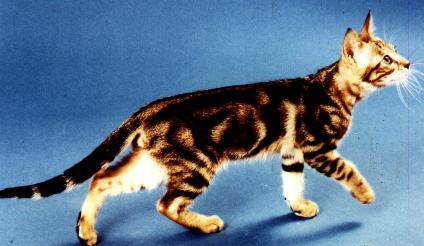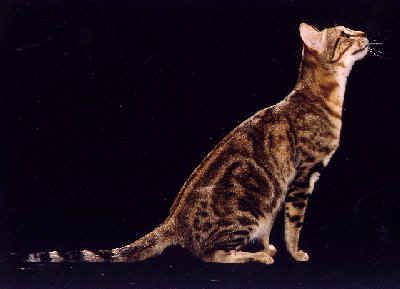|
|
|

General Information:
The Sokoke is a long legged
moderate-sized cat with a short dense coat without any undercoat. It looks
a little like a ocelot having an "African tabby pattern" with ticked hairs
in the dark part of the pattern. It's movement pattern can be compared
with a cheetahs. They mature very slowly, and only reach sexual maturity
at the age 1.5-2 years.
History:
The Sokoke was accepted
by FIFe in 1993, as the second breed being accepted by FIFe before the
recognition by other cat organizations. There is now two forest cats, the
Norwegian and the Afro-Danish Sokoke making their mark on the world of
cats. It originates from the Sokoke Arabuke forest on the Kenyan coast,
one of the few remaining but rapidly dimishing, rainforests in East Africa.
Not much was known about
the Sokoke cat before the Kenyan farmer Jeni Slater in 1978 found a litter
of kittens in her coconut plantation. Jeni Slater is an experienced horsebreeder
and found the kittens so special that she brought them home as pets. Their
pattern "blotched tabby"
does not exist in East Africa, and their body type is described as "foreign"
(tall and slender) whereas the Kenyan housecats are of the "cobby" type
and with a much thicker coat.
The struggle to save the
Sokoke cats began with two women: Jeni Slater and Gloria Moeldrup. Jeni
discovered a litter of Sokoke cats on her Kenyan farm and began to breed
them, but difficulties with the Kenyan authorities prompted her to
involve a friend, Gloria, in Denmark. Gloria embarked on a breeding
program in her homeland, and the two communicated cats in order to strengthen
the breed. Gloria's legacy,since her death, has been continued by a handful
of cat breeders, such as Helle Lauridsen (of Kibutata cattery). Now,
Shabengals Cattery is enjoining the battle to rescue the Sokoke cats from
extinction. At present there are only 14 known breeding queens in
the world, though there are Sokoke in Italy, Holland, and the greatest
proportion in Denmark. But this is set to change since Shabengals
Cattery kittens into America, a female (February 1998) followed by a male
(August 1998), to form
a breeding pair.
Characteristics and Temperament:
Even if the Sokoke looks
like one of the wild cats and has retained all the characteristics of the
wild cats, does it bond very strongly to its human - independent and loving,
but never clinging. It is totally bereft of aggression and only marks with
teeth or claws if strongly threatened. All muscles tense if in danger,
ready to flee quickly. The Sokoke is a very sensitive cat and swings with
the mood of its human. It is active and quite talkative, having a strong
voice, it is an independent cat but it much enjoys the company of its'
humans. It is a proud and highly intelligent cat and you can communicate
at a high level using voice and and body language.
Because they are totally domestic by nature, Sokokes can be kept without permits and licenses normally required in the keeping of wild or endangered species. These little "cheetahs" are totally dependable in personality, they require no elaborate housing facilities, and they are a practical size for a family pet. Qualities that persevere from the wild are: super efficient ears, eyes and whiskers. Camouflaged coats, agile and athletic bodies, a unique self-confidence, and a high level of intelligence. Additionally, the breed strives to preserve genes unknown among the traditional domestic breeds. FIFe's breed council is taking special interest in preserving these rare genes, and have made strict breeding plans for the few breeding cats. They have not been mixed with domestic cats and are therefore totally unique and is by some though to be a completely independent genera.
Being a cat of the rainforest, the Sokoke has a special relation to water and will just swim across any stream that crosses their path, they don't seem to enjoy it but take is as a part of life. Another special characteristic is their hard muscular bodies, rendered even more athletic by their extremely short coat through which every muscle can be seen.
The Sokoke cat thrives in groups and gets along well with other cats.
Body:
The body is elegant and
very muscular. High on the legs, back legs a bit higher than the front
legs (as seen in many sprinters, e.g. the cheetah). The head looks small
compared to the body. The top of the head between the ears is almost flat
and has the same width as the base of an ear, with high, angular well-marked
cheek bones. Nose medium long and almost straight. Well defined strong
chin. Medium ears in harmony with the head but seem larger. Broad at base
with slightly rounded tips, tufts are allowed.The base of the ears is parallel
with the lines extending from the corner of the eyes. The ears are always
in a listening position. The eyes are almond shaped, obliquely placed.
Colour from various shades of amber to light green, outlined with darker
colour in accordance with the body colour.
Head:
Modified wedge, appearing
small in relation to body. Profile: On top of the skull almost flat.
The nose is of medium length, straight. A short, softly curved bridge to
the front. Broad, with a relatively abrupt end of the tip.
Eyes:
Large, set wide apart, slightly
slanted towards the nose; slightly almond in shape. The eye color
is brilliant and expressive. Amber to light green, outlined with the same
colour as in the solid areas of the pattern.
Ears:
Medium large; broad at the
base. Tips slightly rounded. Tufts desirable on the tips.
Legs:
Long, slender and well muscled.
Hind legs longer than the front legs. Well angled on the hind legs. The
position of the hind legs
is very characteristic for
this breed.
Tail:
Medium long, wider at the
base than at the end.
Color:
Any shade of black tabby. Pattern:
as for all blotched tabbies. However, it is desirable that the pattern
shows agouti hairs in the solid areas, which makes the special appearance
that identifies the Sokoke breed.
Care:
Sokokes need little care
to keep their coats in good condition. Their short dense coat requires
no brushing although strokes with your hand makes the fur crackle with
enjoyment and health. They hardly shed at all. However a good brushing
every day greatly enhances the Sokoke's mental health and it knows nothing
better than sand bathing.
Otherwise, good high protein food, fresh water, regular vet-checkups, regular vaccinations and lots of love is all they need to thrive.
Is This Breed for Me?
If you want a cat which
is playful and interactive, almost "dog-like" in this way, the Sokoke is
a terrific breed. They are loving and affectionate and make wonderful but
never clinging companions. They love talking and can be quite eloquent,
"talking" to you for hours. The noise level of a female in heat can be
quite high.
The Sokoke is not a lap cat,
but will honour you by sleeping in your lap when it so chooses. It does
not enjoy being coddled, but will
follow you on equal footing
always ready to be petted.
If you're looking for a cat
which will spend a great deal of time snoozing peacefully instead of playing,
or a placid cat with a great
deal of quiet and refined
dignity, the Sokoke is not the cat for you.
As the breed is almost extinct
it is of great importance that new Sokoke owners take interest in the breed
and works to preserve it
with careful planned breeding,
or showing. When you get a Sokoke you get more than a cat, you get a challenging
hobby.

HOME
BACK
This page was designed
by Kisser
Site Design and Content © 2001 by
Christina
L. Remien/Kisser
All rights reserved.